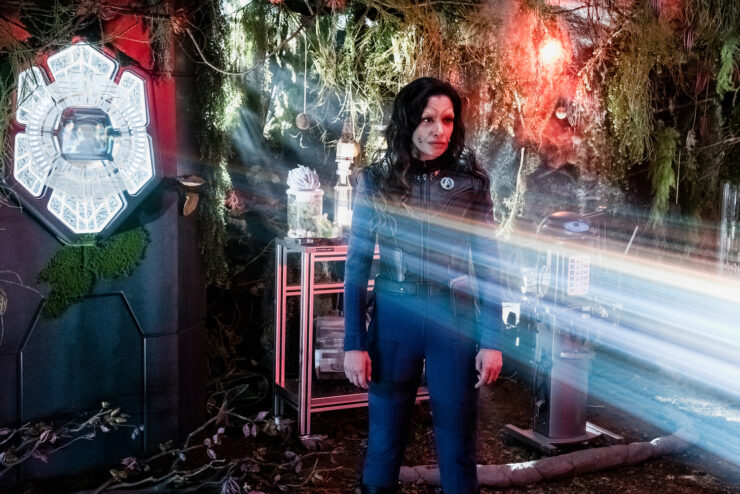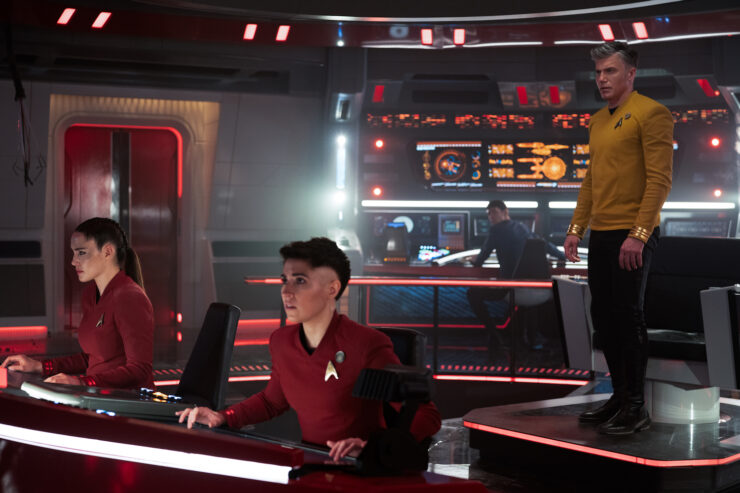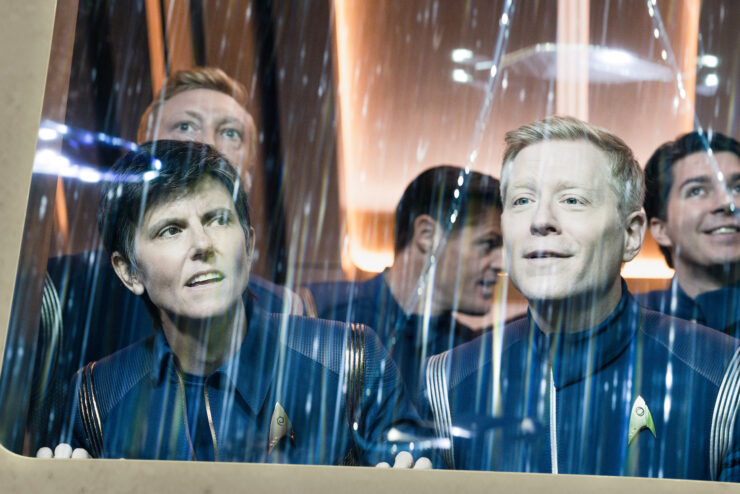All of the new Star Trek shows are distinct viewing experiences, but all of them share at least one thing in common: Their characters face a slew of space-related challenges, almost all of which are based on the best-known science.
Erin Macdonald, who has a Ph.D. in astrophysics, helps keep the latest Trek series as scientifically savvy as possible. She started working as a science advisor on the third season of Discovery and the second season of Lower Decks, and has been involved in every season of every Trek show since then.
I talked with Macdonald recently about her work on various Star Trek episodes, including the third season of Picard. Read on for that full discussion but be warned! There are spoilers in there for past seasons of Discovery, Strange New World, and through the fourth episode of this season of Picard.
This interview has been lightly edited for clarity and brevity.

I’m going to start off with two very specific questions from the Tor.com staff. So question number one: Dark matter. It comes up a lot in the Trek world. What advice or guidance did you provide on dark matter and how much of what we see on the show is plausible given what we know?
We really don’t know anything about dark matter. All we know about it is that there is a gravitational presence of something that takes almost a quarter of our universe and all the stuff we could see and touch and feel is only 4 percent. So dark matter makes up about 25 percent of our universe. And so we’ve utilized it in various ways in Trek. Even when Discovery started in Season One, I think they found an asteroid, and then we had what we called the Dark Matter Anomaly in Season Four,, and we really called it that just because it had a gravitational presence. It was affecting star systems. You couldn’t really see very well you just knew that it was accruing something. And then we also had a dark matter nebula in Season Three with the planet was that was the source of The Burn. So I’m not going to get too much in the weeds, but this actually came out of my little sci-fi brain because I was trying to come up with an explanation for how the Burn happened.

That was my next question!
So my role, because we brought on a biologist too—Professor Mohamed Noor, did all the biology of how Su’kal could be tied to it. For me, it was all about how dilithium could shatter across a good region of the galaxy faster than the speed of light but not instantaneous because they had the black box to triangulate all of it.
So I went down a path of looking at all the ways we’ve talked about dilithium in the past and trying to come up with some science-based explanation. So I went to my mathematical world, which is part of my background. If you think of normal space-time, and then we use sub-space in Star Trek all the time—that’s the area above normal space, or above the trampoline, which was a good analogy for it.
I think about it as like, we have our real plane, which is space-time and then subspace is like the imaginary plane, mathematically. So complex numbers and imaginary numbers. We can do a lot of cool stuff mathematically with that. So I had this idea of, what if dilithium had a subatomic particle that permeated sub-space? It would be like a complex boson, one of these force-carrying particles that does permeate sub-space, and then the combination of those allowed that to go faster than the speed of light.
Suk’ol basically cries out of the resonance frequency of dilithium. And then that sub-space component of dilithium is what sent that signal, that resonance shatter through the galaxy. But the way it ties dark matter is, my little brain a whole rabbit hole of, “What if we have these complex or imaginary force-carrying particles, what if that’s dark matter? What if we just see the mass that’s in sub-space pressing down on our own galaxy or our own universe, and we just can never detect it. We didn’t really put that in the story with the Burn other than it was a dark matter nebula, and we were able to name it the Veruvian nebula after Vera Ruben, who was the woman who discovered dark matter.

Amazing, thank you. So to talk about more recent stuff—let’s talk about Season Three of Picard. I’m guessing there’s things about Jack we can’t talk about yet because spoilers, but what about earlier in the season?
The episode I did the most on was Episode Four where the nebula is giving birth. So we were talking about the gravitational well of the whole thing. And even though that seems really simple and obvious, it’s hard for a science advisor to really tweak the dialogue for it, because you have to make it clear that you’re not getting sucked into a gravity well, you’re not being pulled in, you’re falling in. It’s just this heavy nebula that has this gravitational presence that they continue to fall in.
This is a neat part of my job too—managing the way that we talk about technology throughout the franchise, fiction or not. And so knowing how starships work and when they’re rerouting all the power as the wave is passing by, to be able to send it through the nacelles to absorb and power up the warp core.

Is there any sort of phenomenon in space that you really think is really cool that you’d love to see an episode?
I’ve been lucky that this was one of the first things people asked me when I started. And so we were able to get a coronal mass ejection into Season Three of Discovery. That was the star burp that they had that took out the seed vault station. They literally said, “We need a space disaster. What’s a cool space disaster that you haven’t seen and would want to see?” And then we also incorporated gravitational waves quite a bit as well—my actual Ph.D. was in gravitational waves. So that’s been really, really fun. It’s a very complex topic. And so while we’ve mentioned it, we kind of made it a little bit more fuzzy than the real science, because I think at one point Book surfs the gravitational waves—you wouldn’t really be able to do that, but just the fact that they wanted to include gravitational waves just made my little nerdy heart happy.

And what about Strange New Worlds Season One? Did you have any favorite science stuff from that?
In Episode Four, “Memento Mori,” where they are hiding in the atmosphere of a brown dwarf that’s orbiting a black hole. That’s the Gorn submarine episode. I did a lot of help on that one, just talking about the brown dwarf, talking about the black hole. And then particularly the Pike maneuver, where he slingshots around, but because of gravitational time dilation the Gorn don’t see that he’s done it yet.
All Star Trek shows are now available for streaming on Paramount+.
Vanessa Armstrong is a writer with bylines at The LA Times, SYFY WIRE, StarTrek.com and other publications. She lives in Los Angeles with her dog Penny and her husband Jon, and she loves books more than most things. You can find more of her work on her website or follow her on Twitter @vfarmstrong.










